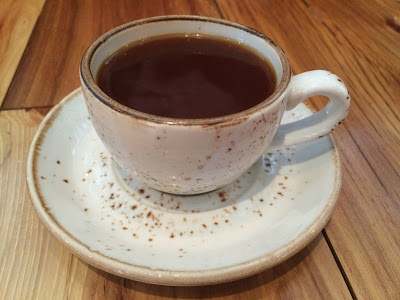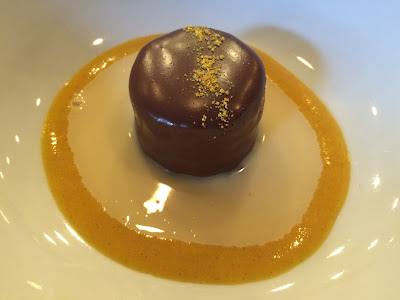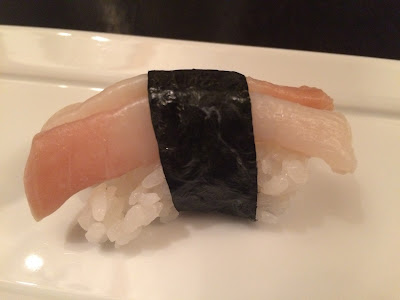“
Mezcal was like a slap to the face from a beautiful woman -- sure it hurts a little, but you savor the sting. Because you know she wouldn’t hit you if she didn’t care.”
--
Judah Kuper, co-owner of
Mezcal Vago
Were you listening to the
400 Rabbits yesterday? Those Rabbits & I
encouraged people to drink more mezcal, to experience the diverse and complex wonders of this agave distillate. You probably know plenty about tequila but you might know little about mezcal, and what little you might know could be merely the myths of mezcal. However, the more you learn about mezcal, I suspect you will find a myriad of reasons why you should be drinking it. Today, let me give you some specific mezcal recommendations, excellent examples of the potential of mezcal.
Last summer,
Amuleto Mexican Table opened on Moody Street in
Waltham and recently hosted their first
Mezcal Tasting. Though I've heard some good reviews of Amuleto, I hadn't yet dined there but was interested in checking out their mezcal tasting. The tasting cost $25, which included samples of 5 Mezcals from
Mezcal Vago along with some small bites. The event was well attended, lots of fun, and the accompanying food was tasty. My only minor issue is that I thought, based on comparably priced events elsewhere, that the size of the mezcal samples could have been a bit larger. As it was their first event though, and they are still learning, it could be remedied in future events.
I am impressed that Amuleto is such a passionate advocate for mezcal. They currently stock over 20 mezcals, from 7 producers/importers, with glasses priced from $9-$34. There are few other local restaurants and bars with that many mezcals so Amulet is a true prize. If you want to sample a few different mezcals, you can order one of their six mezcal flights of three tastes, priced $18-$49. In addition, they make numerous mezcal cocktails, $10-$11, including the
Oaxaca Old Fashioned (Mezcal, Agave Nectar, Bitters) and
Mezcaloco (Mezcal, Coconut Cream, Pineapple Juice). In the future, they will hold other mezcal tastings and maybe even a mezcal-paired dinner.
And I love their cow painting (seen above) which is located near the window into the kitchen.
The mezcal tasting was led by
Francisco Terrazas (pictured above), the brand ambassador for
Mezcal Vago, who also used to run a Mezcal bar in Houston. Francisco was energetic and knowledgeable, with a clear and deep passion for mezcal. He interacted well with all of the tasting attendees, answering their questions and helping to maintain a high energy level at the event. He discussed some basics about mezcal, as well as more specifics about the two mezcal distilleries represented by Mezcal Vago.
Mezcal Vago was founded in 2013 by friends
Judah Emanuel Kuper &
Dylan Sloan. Approximately 15 years ago, they traveled to the region of
Oaxaca and tasted Mezcal for the first time, having a revelatory moment. They loved the region, were intrigued by mezcal and eventually started a small beachside bar on an island west of
Puerto Escondido. Judah married a nurse named
Valentina whose father,
Aquilino Garcia Lopez, made mezcal and whose family had been producing mezcal for at least five generations.
Judah and Dylan saw an opportunity, to introduce Americans to some of the artisanal mezcal that was being produced by small Oaxaca producers. Much of that mezcal wasn't yet being exported, consumed only by locals. They currently work with two producers,
Aquilino Garcia Lopez and another related producer,
Salomon Rey Rodriguez. Their mezcals are available in 22-23 U.S. states and that will grow in the near future.
As Judah says, "
With my old friend Dylan, we formed Vago, a company that exports Oaxaca’s finest, most undiscovered mezcals. We will feature many different mezcals and always have something new and different. Mezcal, like wine, varies with each batch. Much of the mezcal will come from my father in law, such as our Espadin and the Elote, but others, such as our Tobala and Madre Cuixe, found hard-fought on this epic journey, will come from other remote towns, from master mezcaleros whose mezcals must be shared with the world.”
All of the Vago mezcals are naturally made, in a traditional
palenque, without any additives. They are also
joven, meaning that they are not aged. It isn't traditional for them to age mezcal though Francisco stated it is for some other producers. They have done a little experimentation with aging, especially in clay vessels, but haven't released any aged products.
It is cool that the front label of each bottles contains plenty of info about the mezcal, including: the name of the agave variety, name of the producer (the
mezcalero), name of the village, the method of grinding, the type of still, name of the parcel, batch size, distillation date, and age. The alcohol content is also listed and it should be noted that the alcohol content will vary from batch to batch, though not significantly, even for the same agave variety.
Francisco mentioned that they are still learning about agave. I think that is a very important point, that the full potential of agave and mezcal has not yet been realized. Mezcal production can only improve, creating something that is even more compelling. There is still plenty of room, as well as need, for experimentation and study, to enhance and improve the mezcal process in so many different ways. We need to give our support to those expanding our knowledge of agave and mezcal.
In Oaxaca, a traditional accompaniment with mezcal is a plate of orange slices and
sal de gusano, worm salt. This is not euphemism and actually is made with crushed worms, along with some salt and chili powder. The orange and salt are intended to be a palate cleanser while you sip the mezcal. Though we didn't have any sal de gusano at our mezcal tasting, Francisco brought something equally as good,
sal de chapulin, which is grasshopper salt. It was salty and spicy, with a slight nutty accent. And you never would have known it contained grasshoppers unless someone told you.
Five mezcals were served at the tasting, from the two different distilleries. A bottle of Mezcal Vago generally costs $50-$125 retail, dependent on the variety and rarity. These are reasonable prices considering several factors, such as the laborious efforts that go into producing this mezcal, as well as the rarity of some of the agave varieties. In addition, remember that the agave can take 7-25 years to mature and dies after it blooms.
Aquilino Garcia Lopez has started producing mezcal for the first time on a commercial basis and they are exclusive to Mezcal Vago. They grind their agave with a traditional
tahona, which is pulled by a horse named
Señor Pancho. For roasting the agave, they used a combination of
Sabino, a type of pine, and fallen cactus ribs. They also have seven pine wood vats and a copper still. Aquilino usually leaves a little residual sugar in the fermentation vat so the mezcal doesn't get too acidic. Aquilino’s mezcals are supposed to possess a definite style: "
Bright, clean and bold without too much smoke."
Salomon Rey Rodriguez, known as
Tio Rey, has also started producing mezcal for the first time on a commercial basis and they are also exclusive to Mezcal Vago. Instead of a tahona, they crush the piñas, with 40 kilogram wooden mallets known as a
mazos. Tio Rey has 4 fermentation vats, including one made from a 900 liter trunk of a pine tree which has been in use for over 90 years. For distillation, he uses clay pots, known as
Olla de Barro. The whole production process is long and laborious, taking about four times as long as that of Aquilino.
We began the tasting with the
Espadin produced by
Aquilino Garcia Lopez in the small village of
Candelabra Yegole. About 75% of all mezcal is made from Espadin, which is the genetic mother of Blue Weber Agave. It is easy to cultivate, matures in 7-12 years, and has a high sugar content. In addition, it grows small clone plants in about 3-4 years which can be replanted. That is good in some ways, but also has a potential problem for being monoclonal, which could lead to plant diseases and more. For Aquilino, on average, an Espadin will yield seven bottles of Mezcal and the average batch size is about 750 liters. I found this Espadin to have clean flavors with pleasing citrus, some herbal accents, a hint of caramel and a mild touch of smoke. Easy drinking and smooth, this would make for a nice introductory mezcal which should appeal to a wide audience.
The
Elote, also produced by Aquilino Garcia Lopez, is made from Espadin but roasted corn is added during the second distillation. Sun dried corn kernels are toasted on a clay
comal before being placed into the still. With a mild smokiness, the sweetness and flavor of the corn is prominent, enhanced by some herbal, citrus and honey notes. This would be a nice introductory Mezcal, as the smokiness is restrained and the slight sweetness makes it a bit more mellow. For Mezcal lovers, it presents a more unique taste profile which should intrigue and satisfy.
One of my favorite mezcals of the evening was the
Mexicano, also produced by Aquilino Garcia Lopez. Also known as
Maguey de Monte, the Mexicano is a wild naturally growing agave and yields a little less than seven bottles of Mezcal. As Mexicano can be very delicate, Aquilino added 10% of Espadin to this batch to provide it a little body, especially on the finish. I found this mezcal to be elegant and complex, with a compelling melange of flavors including a stronger smokiness, some roasted agave, caramel, and hints of stone fruit. It was smooth, well-balanced and delicious, an excellent mezcal to slowly sip and savor. Highly recommended.
The
Cuixe, also produced by Aquilino Garcia Lopez, is made from the Cuixe agave, a wild sub-variety of Agave Kawinskii that is indigenous only to a small area of Oaxaca. It takes a lot of time to scour the countryside seeking ripe agave, and some, located atop mountains, must be brought down by burro. It also takes extra effort to clean, prepare, grind and roast the Cuixe. Aquilino only makes two small batches of Cuixe each year. This mezcal possesses more of a smell of fresh hay and was very dry on the palate, with a mild smokiness and more prominent herbaceous flavors. It certainly had a more unique flavor than the previous mezcals we had tasted.
The
Ensemble en Barro was produced by Salomon Rey Rodriguez and it is a blend of agave varieties, including Espadin, Mexicano, Coyote, Arroqueno, and Sierra Negra. The blend will vary with each batch. This was distilled in clay pots in a small batch of 180 liters. This was another smooth, easy drinking and delicious mezcal with a pleasing taste of citrus and banana, with a slight smoky edge and some herbal accents. There is also a subtle earthy undertone which serves to add complexity and flavor to the blend. You don't get much more artisan than the mezcals of Tio Rey.
After the tasting, Francisco shared a couple other mezcals with a few of us, more small batches which are no longer available. The first was the
Tepazate, produced by Aquilino Garcia Lopez, and it was my top favorite mezcal of the evening. The Tepazate agave, also known as
Dub-Cual, is a wild variety which grows quite large and can take as long as 25 years to mature. This mezcal had an impressive and complex taste, with lots of smoky and earthy elements, plenty of herbal notes and hints of citrus and stone fruit. I could have sat there for hours sipping this mezcal, extracting subtle hints of other flavors as well. This is one of Francisco's favorite mezcals and it is easy to understand why. Highly recommended.
Lastly, we tasted the
Coyote en Barro, produced by Salomon Rey Rodriguez, and note that a 100% Coyote agave mezcal is very rare. This mezcal had a mild musty aroma with an intriguing taste of a mild smokiness, strong briny elements, bright citrus and a light earthy touch.
Kudos to
Amuleto Mexican Table, Mezcal Vago and
Francisco Terrazas. They are spreading a passion for mezcal and their passion is infectious. It was clear at the event that most of the attendees were impressed with the mezcals and would be seeking them out in the future. Mezcal Vago is importing some intriguing and delicious mezcals, which though they are not inexpensive, they are definitely worth the price. These are artisanal products, produced in traditional methods by small family distilleries. I strongly recommend you seek out the mezcals of Mezcal Vago.





















































